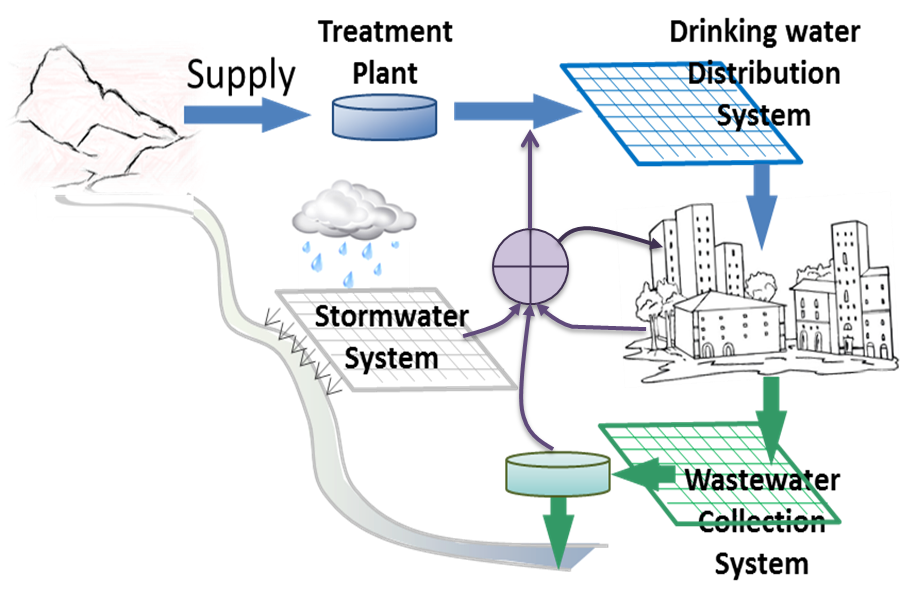By Neil Grigg
Extensive investments and management reforms are needed to provide much-need water services in urban areas around the world. Cities and towns are experiencing rapidly-rising population and massive urbanization. The global population has passed seven billion and for the first time in history more people live in urban areas than in rural areas (World Health Organization, 2015). It is a double whammy: both world population and the percentage living in cities are rising. This double-compounding of growth puts great pressure on urban water systems and the result is rapidly-escalating urban demands for water, growing competition, conflicts, shortages, waste and degradation of water.

The water services needed should provide safe drinking water, adequate and convenient sanitation, effective wastewater management, and drainage and flood control systems to support healthy and sustainable cities. Each of these services requires complex infrastructure and management systems, which are either not in place or not working well in the places where billions of people live. The evidence is easy to find in waterborne disease outbreaks, polluted streams, and frequent flood miseries in cities (United Nations Environment Programme, 2015).
Without effective intervention, the situation will worsen and pose a major challenge to sustainable urban development, especially with climate change (Biswas, 2011). While many city dwellers already lack access to safe drinking water, it will be even scarcer in the future. Affordability of water is a large issue in many countries, but many sources of water must be treated at high cost and volumes of wastewater are growing. As cities seek new sources of water and discharge their effluents, nearby communities suffer and ecosystem services are disrupted. These issues will be particularly acute in low-lying coastal zones, which are home to a large fraction of the urban population globally.
Urban water managers must rethink conventional concepts. A shift is required from managing services by stovepipes in isolation to a sustainable integrated approach supported by stakeholders. This approach should feature integration of infrastructures, integration of services, and integration in the nexuses of water-related sectors. It must also provide sustainable solutions that are equitable for all sectors of society.
Integration of infrastructures, services, and sectors
The infrastructures of water supply, sanitation, wastewater management, and stormwater should be integrated to provide a seamless and sustainable use of technologies to provide needed and sustainable services. A good test for the effectiveness of these is whether they are enabling the city to reach net zero status in providing water, preventing pollution, and sustaining urban ecology.
The integration of services means that customers can look to their cities or utilities for a full range of affordable and sustainable urban water services. The provision of services provides the playing field where the economic goal of efficiency and the social goal of equity meet. Utilities face enormous challenges in mobilizing infrastructures, workforce, and organizational systems to develop and sustain effective public water services.
The integrated urban water system is locked into a series of nexuses with society, energy, food, and the environment. These nexuses can be expressed at different scales but they offer an explanatory paradigm to illustrate how water is a connector and must be managed in tandem with water-related sectors. For example, the water-society nexus explains that water service is both a public and private good and must be developed with multiple objectives in view, such as sustaining public health as well as economic vitality. Inadequate public services are especially hard on marginalized communities with urbanization resulting in vast numbers of new arrivals to uncertain conditions with greater poverty and without water security.
Challenges
As cities grow and their built environments harden, integrated urban water systems should show the way toward sustainable approaches such as green infrastructure and net zero water impacts. These require transformations in urban planning and conceptual designs, but they also attract strong institutional resistance as people push back against costs and new thinking about development patterns.
Institutional resistance is a framework for the many challenges faced by proponents of
integrated urban water systems. They will require massive funding, but many cities
have limited ability to invest in them and even where finances are more adequate, water systems are under-valued and face stiff competition for funding. To move the needle will require transformations in institutional practices. Given the massive problems in large cities, the greatest opportunities for innovation may be in small and medium-size cities where instilling different approaches in governance is more feasible.
Another challenge is the complexity of integrated urban water systems. For example, practices proposed are normally fragmentary and not comprehensive. Evidence is seen in the principles suggested by the Global Water Partnership (2011), which include alignment of water sub-sectors within cities and beyond; water conservation and efficiency efforts; water sensitive planning and design; stormwater and wastewater source control; pollution prevention, and flow and quality management; use of mixtures of ecological solutions and infrastructure; and use of non-structural tools such as education, pricing incentives, regulations and restriction regimes. This is an excellent list of practices but it is only a sample of the many innovations needed.
If urbanization, cost, and complexity were not challenging enough, the specter of climate change faces many cities, especially those in low-lying coastal areas. Climate change many bring warmer temperatures, more frequent heatwaves, and increasing droughts and floods. Some regions will also see more intense tropical cyclones and rising sea levels. This will impact water supply and sanitation and increase flood damage and water treatment requirements, while working against water availability and operational capacity. These areas must be prepared for better water security to become more resilient to climate change.
A stark reality in the vision of integrated urban water systems is the case of struggling cities where public services fall way below minimum standards. Still, rays of hope can be found in new ideas about leapfrogging the mistakes of past world cities to implement locally-based solutions even amidst sprawling conglomerations with many shades of cultural patterns (Tucci, 2009).
The road ahead
A great deal is known about the concept of integrated urban water systems, but the challenge is to bring them about. Examples of visionary approaches include those by the Global Water Partnership (2015), which has published a series of principles for integrated urban water systems management. These include: protecting water resources at their source; integrating water storage, distribution, treatment, recycling, and disposal; and encouraging participation by all stakeholders; among other practices. Another example is the vision of the future environmental utility, such as expressed by thought leaders at conferences such as at the Wingspread forums (Johnson Foundation, 2015).
As cities respond to these visionary paradigms, they must reduce risk by encompassing alternative water sources; protect water quality, both in distribution systems and in the environment; integrate infrastructure of water storage, distribution, treatment, recycling, and disposal; and promote social equity by aligning formal and informal institutions and practices.
Achieving these goals will require policies and strategies supported by financial and institutional capacity. Technological developments such as water treatment and green infrastructure must be delivered and implemented with effective tools for decision-making in cooperation with both public and private sector partners. Regulators must be more flexible to enable innovations while protecting the public in essential ways. Integrated urban water systems based on participatory governance can promote sustainable development, but great efforts will be needed to stimulate innovation, efficiency, and sustainability.
References
Biswas, Asit. (2011). Evolution of global developments in urban water management: Part 1 of 2. November 14, 2011 http://www.globalwaterforum.org/2011/11/14/evolution-of-global-developments-in-water-management-part-1-of-2/
Global Water Partnership. (2011). Towards Integrated Urban Water Management. Perspectives Paper. http://www.gwp.org/Global/ToolBox/Publications/Perspective%20Papers/01%20Towards%20Integrated%20Urban%20Water%20Management%20%282011%29%20English.pdf
Global Water Partnership. (2015). Integrated Urban Water Management (IUWM): Toward Diversification and Sustainabiltiy. Policy Brief.
http://www.gwp.org/Global/Activities/News/August%202013/GWP%20Policy%20Brief_TEC%2016_FINAL.pdf
Johnson Foundation. (2015). Charting New Waters.
http://www.johnsonfdn.org/aboutus/chartingnewwaters
Tucci, C.E.M. (2009) Integrated Urban Water Management in Large Cities: A Practical Tool for Assessing Key Water Management Issues in the Large Cities of the Developing World. World Bank.
United Nations Environment Programme. (2015). Integrated Urban Water Management. http://www.unep.or.jp/ietc/brochures/iuwm.pdf .
World Health Organization. (2015). Urban population growth.
http://www.who.int/gho/urban_health/situation_trends/urban_population_growth/en/

Jal board for new connection